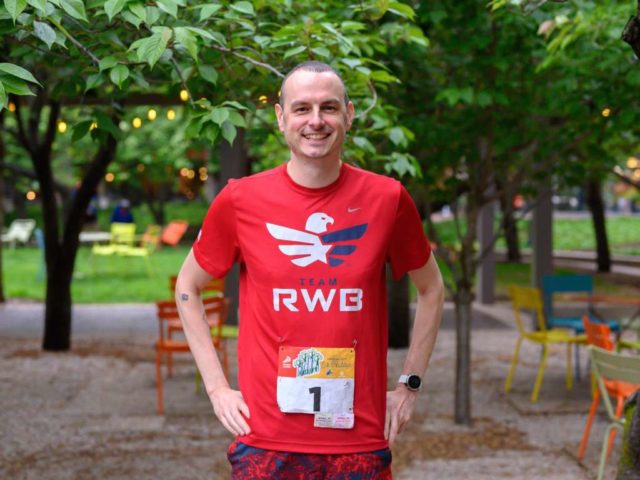Race in Arlington or Washington often? Michael Lynch may be a familiar face.
In addition to running races regularly, Lynch leads weekly group runs from Lululemon in Clarendon, served as the running coordinator for Team RWB’s Washington, D.C., chapter for two years.
Jason Taylor, the current running director for the local Team RWB chapter, described Lynch as an “amazing asset in the running community, both for Team RWB but also for Pacers as well.”
Lynch, 40, of Arlington, served in the Air Force from 1998-2007 and now works for the Department of Defense as an IT contractor. He ran a little during his time in the military, but he really got into it after being drawn to the Crystal City Twilighter 5K and its tech shirt in 2008.
Now, he has a bunch of race bibs and medals from years of racing. He said running also serves as a stress reliever.
“It’s my vice, but I consider it a good vice,” Lynch said.
Team RWB — which stands for Team Red, White & Blue — helps get veterans engaged in the cities and towns in which they live, and the Washington, D.C., chapter offers numerous group run opportunities. The run that Lynch leads at Lululemon is one of the Team RWB runs. Some runs, like that one, were existing store-based runs that Team RWB members are invited to join, he said.
Those runs are Monday nights at 6:30 p.m. and attract about 15-20 people during the warmer months, he said. He’s been leading the group runs for about a year and attended them for about two years before that, he said.
Rather than split off at individual paces, Team RWB members generally stay together or form smaller groups at group runs, he said.
“We try to be very social on our runs, so a lot of the group runs are actually literally groups,” Lynch said.
And, people don’t have to be members of the military — or even have a military connection — to join Team RWB, he said. It’s free to join, and the D.C. chapter is made up of about half military and half civilians, he said. Veterans get the team’s well-recognized red shirt for free, and civilians can purchase one.
Lynch has been a member of Team RWB since 2015. He said he considers his “crowning achievement” as running coordinator for the local chapter to be bringing Pacers Running and Team RWB together for a partnership that includes Pacers race discount codes, store events and VIP treatment at the Parkway Classic. Team RWB, which is a nonprofit, also benefits from Pacers’ Veterans Day 10K.
“I’ve enjoyed seeing it continue on as I left the role I was in,” Lynch said.
Taylor now has that role, and the person who held the role in between them moved, so Lynch has been able to help Taylor when he has questions, Taylor said. Falling under his position are the fun runs, which are led by run leads like Lynch, and coordinating opportunities with different races, Taylor said.
Taylor, who also works as a senior salesperson at Pacers Running and as a running coach, missed being part of a group once he retired from the Air Force after 21 years in 2016.
“I think that’s something that Team RWB is great at is giving people that sense of community that are no longer in the military,” said Taylor, who lives in Alexandria.
Lynch served as an ambassador for Pacers Running, and even though the program no longer exists, he hasn’t changed his tune. When heat forced the cancellation of the inaugural Wayfarer’s Annapolis Half Marathon, Lynch battled back on social media when naysayers criticized race management.
“He was just so nice and I feel like that is such a snapshot of who he is,” said Heather Jeff, event manager for Pacers Running. “Where he shows up, he brings a great energy, he encourages others, yet he’s very loyal and thoughtful about his own voice and where he puts it in, and I think that’s really cool.”
Jeff said she sees him often at events and he’s the kind of runner that has goals but that is also able to not take running too seriously — a good thing.
He also makes sure to express his love for the organizations he’s involved with when he’s out there on the roads.
“One thing I think is really sweet about him is when you see him racing or running, he is very cognizant to rep all of his brands, so he often is in RWB shirt, a Pacers hat and maybe Lululemon shorts,” Jeff said. “He is loyal to a fault and I think the way he presents himself is absolutely adorable.”
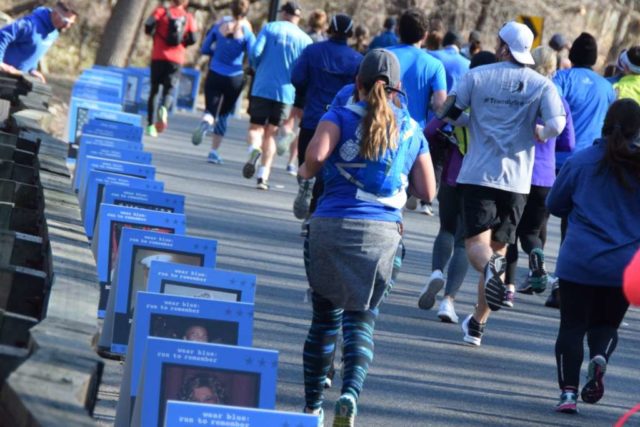
Joshua Harmon started running while serving in Iraq. His wife, Kristin, wasn’t a runner, but she told him she’d run with him when he came home.
He didn’t come home.
Harmon was killed in action on Aug. 22, 2007, at the age of 20.
Kristin, who remarried in 2012 and now has the last name Johnson, has been able to run in Harmon’s honor through wear blue: run to remember, a nonprofit with communities across the country, including in Northern Virginia, Bethesda and Quantico. She lives in Alexandria.
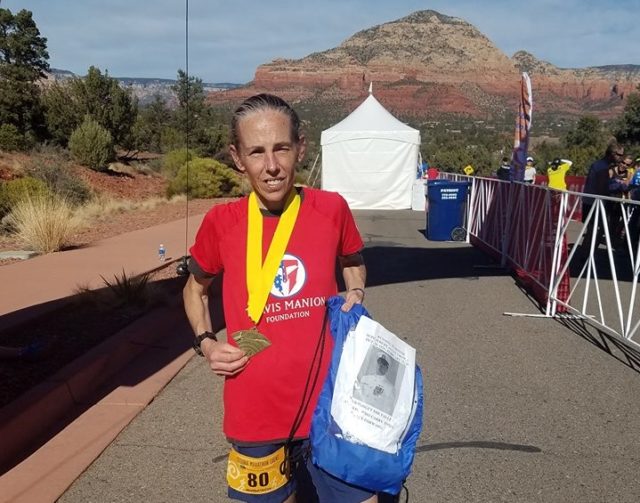
When Jennifer Hickey completed last year’s Oklahoma City Marathon, there was a big surprise waiting for her at the finish line.
Hickey had dedicated the race to Army Sgt. Daniel Eshbaugh, a member of the Oklahoma National Guard who was killed in September 2008 in a helicopter crash while serving in Iraq.
He was one of the dozens of fallen soldiers honored by the D.C.-based runner last year, in her quest to run at least 53 marathons in 2018 to remember those who died serving their country.
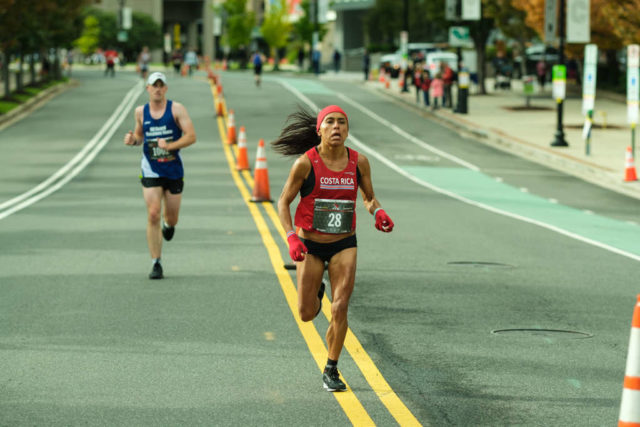
Jenny Mendez Suanca won a face-off among three Marine Corps Marathon champions, running 2:40.19 for her second title, following her win in 2015. Defending champion Sarah Bishop, of Dayton, Ohio finished fourth in 2:49:49 and 2013 winner Kelly Calway, of McLean dropped out after 10 miles with hamstring concerns.
Suanca’s time is the fifth-fastest winning time for the race and bests Calway’s record for this course layout, 2:42:16.
Suanca, 38, of Costa Rica took the women’s led early and stretched it out to a six-plus-minute lead over San Antonio’s 1st Lt. Lindsay Gabow, who was second in her first marathon, running 2:46:34.
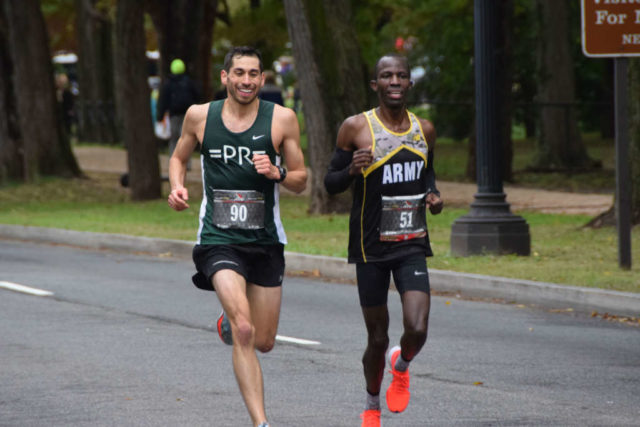
Jeff Stein spent the afternoon following last year’s Marine Corps Marathon recovering in the hospital after heat stroke finishing in eighth place. He fared considerably better this year, breaking the tape in 2:22:49 for his first marathon victory.
True to his buildup this year, it was a race that, for him, seemed decided only at the end.
“When I was in the last mile, I heard the announcer say the leader had someone right on his tail,” Stein said. “I got pretty worried because I knew Patrick (Hearn) was a strong second-half runner, and I was wasn’t sure how much my legs could take. I was fleeing him for the last few miles.”
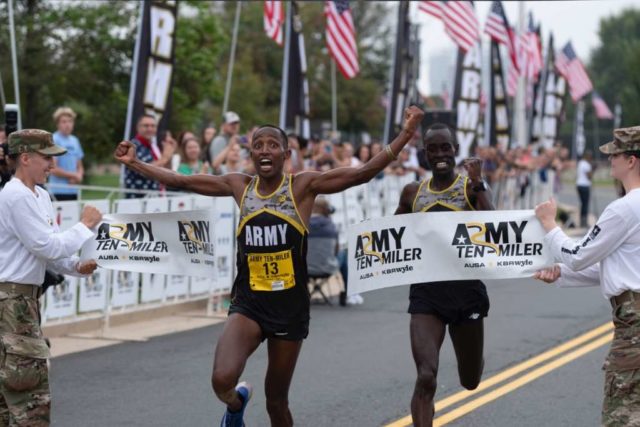
For the second straight year, high humidity met Army Ten-Miler runners, but this year’s race was mercifully cooler. But last year’s conditions still stung Susan Tanui, so when the defending women’s champion set out, she made it a point to start out conservatively. It paid off, with a 56:33 victory over Julia Roman-Duval’s 57:17.
Tanui improved by 17 seconds over last year’s time and Roman-Duval improved by two minutes. Tanui, a member of the Army’s World Class Athlete Program, is stationed at Fort Carson in Colorado. Roman-Duval lives in Columbia, Md. Emily Da La Bruyere, of D.C. was third in 59:07.
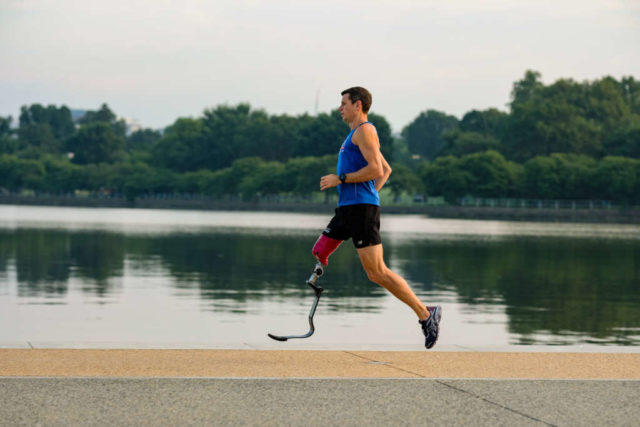
When Adam Popp heads to the start line at the Navy Air Force Half Marathon on Sunday, the pain of the marathon he ran just days before will be fresh. But the Air Force veteran who lost his right leg above the knee after an explosion in Afghanistan in 2007 knew he had to make room in his schedule for the half marathon that holds special meaning to him. In 2015, only four months after he took up running seriously, Popp finished the Navy Air Force Half in 1:44:29 — much faster than his first try at the distance eight years earlier.
“Long story short, I ran that half marathon faster than I had when I had two legs,” Popp said.
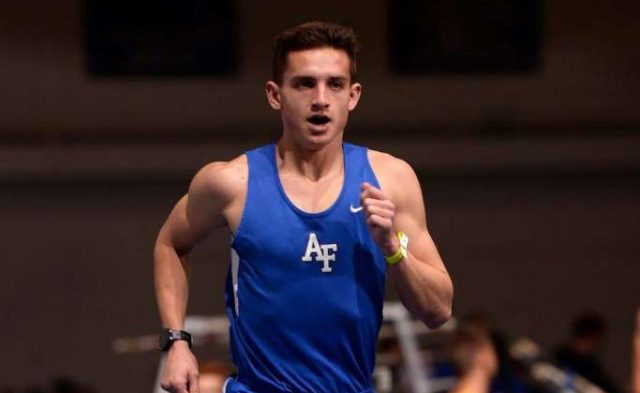
Military academies are some of the most revered institutions in the country. Many only take in around 4,000 students in total. Among that small number of students, even fewer compete in varsity athletics. Meet three local athletes now running at the United States’ military academies.
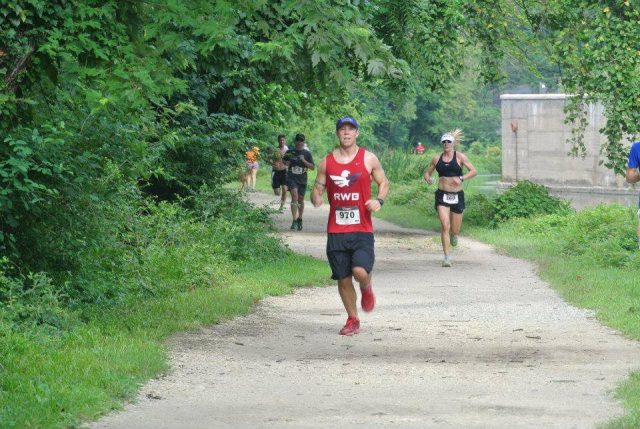
Josh Estep struggled to finish his first race.
Estep was in the Air Force and stationed in Florida in 2011 when he signed up for a 10k.
“The last couple of miles I was huffing and puffing and pouring sweat,” he said. “I thought anyone who runs more than 10k — you’re crazy. Anything more than that, you’re going to die.”
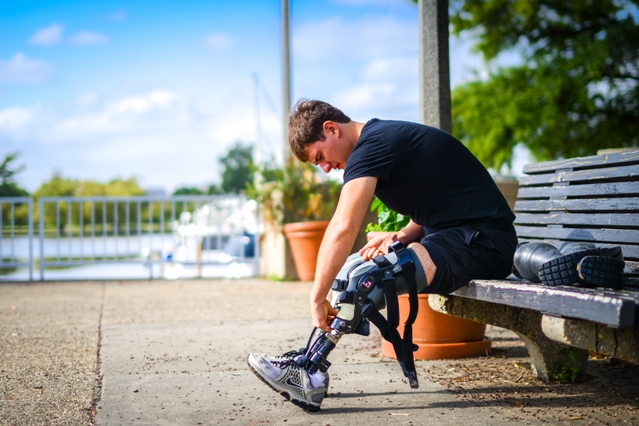
They’re often the first ones out of the gate at races, cranking wheelchairs along courses and chasing the thrill. No matter what was taken from them, they won’t relent in their pursuit of happiness.
John Mullen tried that – hand-cranking the Army Ten-Miler – but he wanted more. He was wounded in Afghanistan while serving in the United States Army. It was there he began his journey from the perils of the
combat zone, to learning how to walk again, and then learning to run as a double amputee. Prevailing over adversity, picking the harder road.
Mullen grew up playing football, basketball, running track and field and competing in Olympic weightlifting. When he enlisted in the Army in July 2009, he displayed such strength and endurance during his first day of physical training that he was tabbed to be a 240 Machine Gunner, a routine that would involve carrying more than 100 pounds in gear. After completing the required training, he joined the 10th Mountain Division, which deployed to Kandahar, Afghanistan in May 2011.
“My division monitored a village that had seen increased Taliban activity,” he said. They worked in 72-hour cycles, with a one-mile trek between the posting and command outpost. For three months, Mullen worked this
routine without incident. But the Taliban had been monitoring the duty patterns.
The Taliban opened fire while Mullen’s shift was en route. Once the relieving platoon got the situation under control, Mullen’s platoon headed back to the command outpost. Suddenly he fell to the ground.
“I was engulfed in a world of white,” he said. “I was unable to comprehend what had happened.”
Mullen had stepped on an improvised explosive device (IED). The explosion tore off his legs a few inches below the knee, removed part of his thumb, and damaged nerves in both of his arms. Sensory overload prevented him from being able to pinpoint what was injured. Through two shots of morphine, he heard the words “double amputation” over the radio transmission.
The medic and radioman applied tourniquets to both of his legs and tended to his wounded arms, saving his life from blood loss. One month later that same medic who was instrumental in saving John’s life was killed in action.
Mullen was transported to Kandahar AFB and then on to Bagram AFB, Landstuhl Regional Medical Center in Germany, then to Walter Reed National Military Medical Center in Bethesda. After surviving this ordeal, he faced the physical and emotional reality of recovering from his injuries and answering the question, “what now?”
Mullen spent his early time in Bethesda looking at photographs he had taken while in Afghanistan. “Every picture told a story,” he said. “They bring me back to that exact moment in time.”
He realized his passion for photography and decided to pursue it professionally. They were his first mental steps, but his first physical steps still remained. He had to learn how to walk with two prosthetic legs. In October
2011, four months after being injured, he received his first prosthetics. But an infection in his leg required surgery and delayed his return to walking for a few more months.
The prosthetic process is complicated.
“It’s like taking myself to the auto-body shop,” he said.
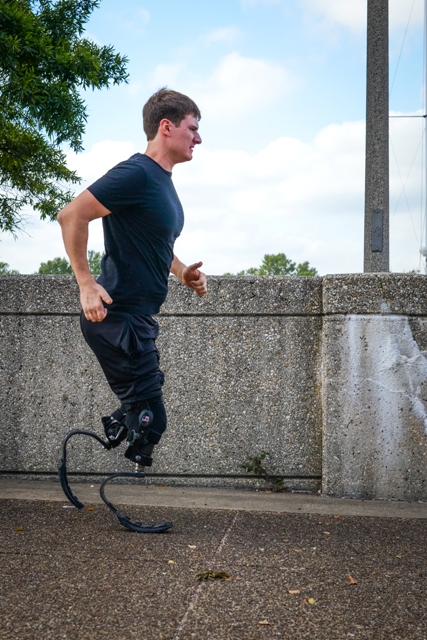
The casts of his legs were taken to create molds for his leg sockets. Adjustable plastic sockets were made from the molds and fitted over the leg so that small changes could be made to the socket to reduce hot spots, pain, rubbing, and discomfort. Once the plastic sockets were fitted, the carbon sockets are made to connect to the prosthetics. Finally, a prosthetist helped determine what type of legs and feet he should use based on how his body naturally moved as he walked with the prosthetics.
Changes in muscle size, bone growth, sore spots and chafing in the amputated limb required a “return to the shop” every few months.
“I felt limited in how much and how fast I could move,” he said. “I wanted to do everything I used to do, including run.”
In September 2013, he was fitted for running legs, a process just as time consuming as getting fit for walking legs. Learning to use running legs, however, was even more challenging than learning to walk. His stiff, predictable limbs and feet were replaced with two flexible blades with a narrow ground contact area. For amputees, going running is not a simple process. Switching leg braces to running legs takes 10 minutes. Once standing in running legs, there is no rest position; Mullen must keep moving to maintain balance. The first week with running legs Mullen could do a five-minute running interval followed by a five-minute rest interval for approximately 30
minutes. In little more than a month, Mullen increased his run interval time to 15-plus minutes, but struggled with increased soreness from the impact of running on the amputated limb and the new movements associated with the running legs.
“I haven’t reached a point of enjoyment with running,” he said.
But he has no intention of stopping. No matter how long it takes, he’ll make it to the starting line, he said.
In addition to achieving his physical goals of walking and running, Mullen achieved a goal he set in his hospital bed in Bethesda. In August 2013, he earned a B.A. in Photography from the Boston University Center for Digital Imaging Arts. He now works as a professional photographer, and enjoys taking portraits of the elderly.
“I can see the life stories in the faces of my subjects,” he said.
As he says this I can’t help but look into his face to see his story. What I see are the clear determined eyes of a man who is undeterred by any challenge. A man who selflessly served his country, overcame the loss of both legs, and continues to pursue everything in life with a fervor and passion unmatched by most.


